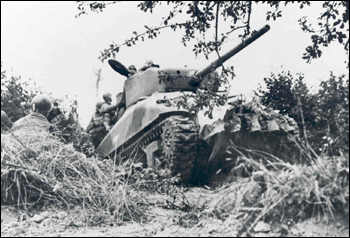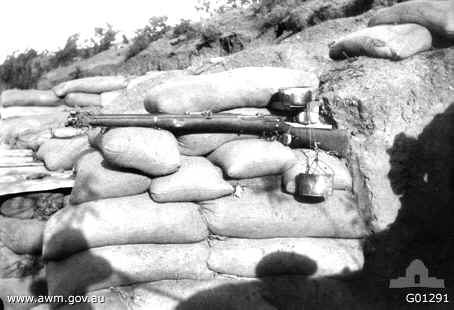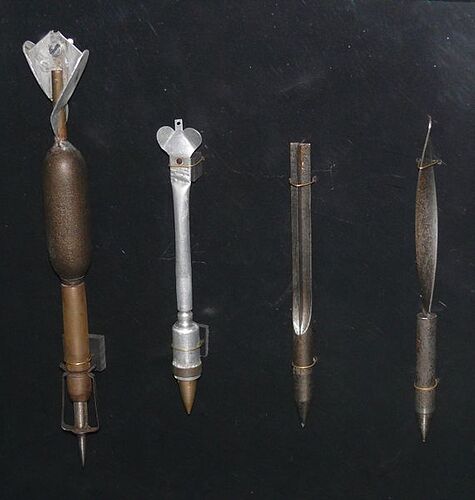.
Delayed fire rifles.
Drip (or “pop off”) rifles were self-firing rifles used at Gallipoli to deceive the Turks during the evacuation of December 1915.
Fire was maintained from the trenches after the withdrawal of the last men, by rifles arranged to fire automatically. This was done by a weight being released which pulled the trigger. Two kerosene tins were placed one above the other, the top one full of water and the bottom one with the trigger string attached to it, empty. At the last minute, small holes would be punched in the upper tin; water would trickle into the lower one, and the rifle would fire as soon as the lower tin had become sufficiently heavy.
Another device ran a string, holding back the trigger, through a candle, which slowly burnt down, severed the string, and released the trigger.
Such devices provided sporadic firing which helped convince the Turks that the ANZAC front line was occupied long after thousands of men had crept down to the beaches and escaped. British generals estimated that half the force would be lost in any attempt to withdraw because the Turks could not fail to notice as the trenches were so close. In the event, the Turks were so deceived that 80,000 men were evacuated with only about half a dozen casualties.
The drip rifle was invented by Lance Corporal W. C. Scurry of the 7th Battalion, AIF, with assistance from Private A. H. Lawrence. For the part he played in making the evacuation a success, Scurry was mentioned in dispatches, awarded the Distinguished Cconduct Medal, and promoted to sergeant.
The wider background to the delayed firing rifle at Gallipoli.
WHEN it was finally decided, early in December, 1915, to withdraw all the British, French, and Anzac troops from Gallipoli, the total of all soldiers at the three fronts, Helles, Anzac, and Suvla, was 134,000. Of these, 41,000 were at Anzac and 50,000 at Suvla.
It sounds very simple to say the soldiers would be withdrawn but really it was a most difficult and dangerous job. The whole idea had to be a very great secret, so that there would be no possibility of the Turks hearing of it. Even the soldiers who were to be taken away must believe that they would be coming back. They were told that they were going away for a rest, as fewer soldiers would be required for fighting during the approaching winter.
Not only did the soldiers have to be taken away, but there were guns and stores to be got off too, without the Turks noticing it. It was arranged that the troops at Anzac and Suvla would be taken away first and those at Helles later on.
So that the Turks would not see them, troops, stores and guns could be taken away during the hours of darkness only. As soon as night fell, ships would come in close to the shore at Anzac and Suvla and the soldiers, who had come down from their trenches on to the beach, would be taken off to the ships in motor lighters. Ten thousand soldiers, some guns, and a few stores were the most that could be taken off in a night.
While this was going on the front line trenches still had to have soldiers in them, firing their rifles and machine guns, and throwing bombs, so that the Turks would not notice any difference and would not guess what was happening on the beach. It was not possible to take all the troops away from parts of the front line as the Turks would then notice
that there was no firing from these parts and would guess that there were no soldiers there and would break into the trenches.
So the whole of the front line had to be gradually thinned out, still leaving enough men to do the firing and bombing. Each night those who were left had to keep walking along the trenches and firing from different places so that the Turks would not know how thin the line was. In the daytime soldiers were told to walk about behind the trenches where the Turks could see them from a long way off along the coast, and would still think that there were plenty of men there.
Ships came in the daytime and landed a few soldiers and stores so that the Turks would not be suspicious. They would not realize that many more men and stores were being taken away each night. This gradual thinning out went on for a week or more. There was the danger that a heavy storm with rough seas might blow up, as was likely in December, and the loading of lighters at night might be held up, but fortunately the weather kept fine and the embarking of troops and stores went on satisfactorily.
It was decided that the final night of the evacuation at Anzac and Suvla would be December 20th. By the night of December l8th the soldiers holding the front line at Anzac, which was six miles long, had been reduced to 20,000. It was necessary that these, and a similar number from Suvla, be taken off on the nights of December 19th and 20th. Half of these were taken off successfully on the night of the 19th leaving only 10,000 at each place for the final night.
At Anzac it was arranged that 4000 of the final 10,000 would be withdrawn as soon as it was dark, another 4000 between nine o’clock and eleven, thus leaving only 2000 men to defend the Anzac area until the time came for the final men to leave. All went well, the 8000 men embarked and 500 of the 2000 were brought down to the beach leaving 1500 still in the front line.
It must be remembered that these 1500 men were not all at one place in the front line but thinly scattered over the whole Anzac front of six miles. As this line was in the form of a semi-circle, or bow, some of these soldiers were much farther from the beach than others, so that those that were farthest from the beach had to leave the front line first to arrive at the embarking points on the beach at the time arranged.
The posts on the two flanks were abandoned first, with the withdrawal becoming gradual toward the centre, where the line was closer to the pick-up places on the beach.
The final evacuation of the left of the Anzac line was fixed for 1.30 a.m. and for the right for 2 a.m., while the soldiers in the trenches nearest to the beaches, such as Lone Pine and Quinn’s, did not leave till 2.55 a.m. and the last, at Russell’s Top, at 3.14 a.m.
While all this was going on the few soldiers who were left in the trenches still had to be firing their rifles and throwing a few bombs, especially at places like Quinn’s Post where the Turkish trenches were only 15 yards away.
In order to trick the Turks, self-firing rifles were arranged, which would continue to shoot for some time after the last troops had left. The simplest was made by attaching a weight to the trigger of the rifle, which would be pulled by the overbalancing of a certain tin when it filled with water which dripped from another tin above it. When sufficient water bad dropped into the lower tin it overbalanced, released the weight, and fired the rifle. The time it took depended on the size of the hole through which the water dripped, so holes of different sizes were made for each rifle, the average time being about twenty minutes.
Other gadgets were arranged with candles and string, and with fuses. Nearly all units arranged on the final night that a few rifles should be fixed in their trenches and be fired by these methods after the last man had left.
Another successful trick used by our forces was the shovelling of dirt over the top of the trenches so that the Turks would think new trenches were being dug. Fires were kept burning in most cook-houses so that the Turks would see the smoke and think the cooks were still busy there. Periscopes were shown in many places in the trenches and men strolled about behind the lines.
Everything went without a hitch. All men were clear of the trenches and on their way to the beaches at 3.25 a.m. At 4 a.m. the last lighter left the beach at Anzac. A few staff officers and Colonel Paton, who was in charge of the rear guard, remained on the beach for ten minutes in case there were any stragglers, then at 4.10 a.m. they embarked in a small steamboat; the last to leave being Colonel Paton. Two men who had been slightly wounded on the beach, and were the only casualties, were taken off in the last lighter. The evacuation of Suvla was completed with equally small loss at 5.10 a.m.
Before the troops left Anzac three large mines, filled with explosives, had been burrowed under the Turkish trenches at The Nek, a very narrow part of the front line. These mines blew up after the last soldiers had left Anzac, killing many Turks and destroying the trenches. Heavy fire at once broke out all along the Turkish trenches but they were still unaware that the Anzacs had gone. They did not really find out that the trenches were empty until three hours later, by which time the Anzacs were far away and nearing Lemnos.






 Police Stinger.
Police Stinger.



